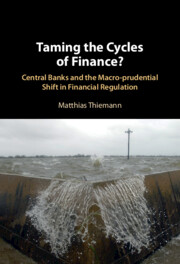Book contents
- Taming the Cycles of Finance?
- Taming the Cycles of Finance?
- Copyright page
- Contents
- Figures
- Tables
- Prologue
- Acknowledgments
- 1 Introduction
- 2 The Changing Regulation of Finance after the Crisis
- 3 The Evolution of Systemic Risk Thinking Pre-crisis
- 4 The Selective Rise of Macro-prudential Ideas in the Wake of the Crisis
- 5 Is Resilience Enough?
- 6 From the Global to the Local
- 7 Taming Liquidity and Leverage in the Shadow Banking Sector
- 8 Into the Upswing
- 9 The Crisis That Wasn’t
- 10 Conclusion
- Appendix: List of Interviews Conducted
- References
- Index
9 - The Crisis That Wasn’t
The COVID-19 Crisis and Its Regulatory Implications
Published online by Cambridge University Press: 15 February 2024
- Taming the Cycles of Finance?
- Taming the Cycles of Finance?
- Copyright page
- Contents
- Figures
- Tables
- Prologue
- Acknowledgments
- 1 Introduction
- 2 The Changing Regulation of Finance after the Crisis
- 3 The Evolution of Systemic Risk Thinking Pre-crisis
- 4 The Selective Rise of Macro-prudential Ideas in the Wake of the Crisis
- 5 Is Resilience Enough?
- 6 From the Global to the Local
- 7 Taming Liquidity and Leverage in the Shadow Banking Sector
- 8 Into the Upswing
- 9 The Crisis That Wasn’t
- 10 Conclusion
- Appendix: List of Interviews Conducted
- References
- Index
Summary
Chapter 9 details the backstopping of the shadow banking system during the beginning of the COVID-19 crisis in March 2020, when central banks around the globe, in particular the Federal Reserve, the Bank of England and the European Central Bank, engaged in massive asset purchases to stabilize the financial system. Within a few weeks, these central banks purchased more than a trillion dollars of assets in order to stem an incipient run on the shadow banking system. Seeing themselves forced to backstop the short-term money markets in this manner in order to contain financial instability, central banks subsequently engaged in attempts to remove the run risks inherent in that part of the shadow banking sector, yet, as the research shows, to little or no avail. Having contained financial instability in a way that largely escaped public attention and hence without arousing political salience, central banks were incapable of overcoming the resistance by powerful financial actors to any further regulation. That is to say, central banks containing financial instability find themselves incapable of removing the underlying structural frailties that make their intervention necessary in the first place.
- Type
- Chapter
- Information
- Taming the Cycles of Finance?Central Banks and the Macro-prudential Shift in Financial Regulation, pp. 220 - 249Publisher: Cambridge University PressPrint publication year: 2024



